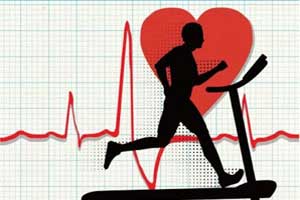- Home
- Editorial
- News
- Practice Guidelines
- Anesthesiology Guidelines
- Cancer Guidelines
- Cardiac Sciences Guidelines
- Critical Care Guidelines
- Dentistry Guidelines
- Dermatology Guidelines
- Diabetes and Endo Guidelines
- Diagnostics Guidelines
- ENT Guidelines
- Featured Practice Guidelines
- Gastroenterology Guidelines
- Geriatrics Guidelines
- Medicine Guidelines
- Nephrology Guidelines
- Neurosciences Guidelines
- Obs and Gynae Guidelines
- Ophthalmology Guidelines
- Orthopaedics Guidelines
- Paediatrics Guidelines
- Psychiatry Guidelines
- Pulmonology Guidelines
- Radiology Guidelines
- Surgery Guidelines
- Urology Guidelines
Home-Based Cardiac Rehabilitation: AHA/ACC Joint Statement

Home based, medically supervised cardiac rehabilitation may be, for some patients, an alternative to traditional medical center cardiac rehabilitation programs after a heart attack or other heart procedure, according to a joint scientific statement by ACC, the American Heart Association and the American Association of Cardiovascular and Pulmonary Rehabilitation published May 13 in the Journal of the American College of Cardiology .
Traditional cardiac rehabilitation programs are provided in a medical center and are implemented by a team of physicians, nurses, psychologists, registered dieticians and other professionals. They help patients recover from heart attacks, bypass surgery, angioplasty, heart failure and other conditions through a program of exercise training, nutrition and psychological counseling tailored to each individual's needs. Cardiac rehabilitation has been proven effective at reducing the risk of subsequent heart attacks, improving quality of life and avoiding additional hospitalizations in addition to other benefits.
However, about 80% of U.S. patients who would benefit from cardiac rehabilitation do not participate, according to Randal J. Thomas, M.D., M.S., chair of the writing group for the statement published simultaneously in the American Heart Association journal Circulation, the Journal of the American College of Cardiology and the Journal of Cardiopulmonary Rehabilitation and Prevention.
"There are significant barriers that prevent patients from getting the cardiac rehabilitation care that they need. And, there aren't enough programs in the United States to meet the needs of every patient that would benefit," said Thomas, a professor of medicine and medical director of the cardiac rehabilitation program at Mayo Clinic in Rochester, Minnesota. "There is an urgent need to find new ways of delivering cardiac rehabilitation programs to patients. Home-based care is an excellent option for some patients who aren't able to attend a center-based program."
The statement presents a framework for home-based cardiac rehabilitation programs that helps ensure patients get scientifically-based, standardized care, Thomas said.
"A home-based cardiac rehabilitation program is much more than advising a patient to exercise at home," he said. "For patients whose heart disease is stable, home-based cardiac rehabilitation is administered and monitored in the same way and by the same health care team as with medical center-based cardiac rehabilitation. The difference is that supervision and coaching are done remotely, using smart phones or other technology."
Thomas said that for a program done in the home to be effective, health care providers should ensure patients are on the right medications and are improving exercise and nutrition habits. In addition, psychological health, medical conditions linked to heart disease, such as diabetes, high blood pressure and high cholesterol, as well as risk factors for heart disease such as tobacco smoking should be addressed. Patients should also be monitored for any heart disease symptoms or for side effects of medications. "All of these components should be in place with a high-quality home-based program - if they are not, patients could be receiving less care than they need," Thomas said.
Heart attack, heart bypass and other heart patients should talk with their health care providers about their rehabilitation options - whether those are center-based, home-based or a mix of the two.
"Unfortunately, cardiac rehabilitation in the home-based setting is generally not covered by most insurance carriers, including Medicare. As more evidence accumulates to support home-based cardiac rehabilitation and the technology advances to make this more feasible, we need to work together with policymakers to find ways for these services to be covered" Thomas said.
Health care systems in the United Kingdom, Canada and other countries successfully offer home-based cardiac rehabilitation, but most U.S. health care organizations have little experience with the home-based option.
Researchers have shown that in many patients with stable heart disease home-based cardiac rehabilitation can achieve results similar to medical center-based cardiac rehabilitation in the months and years following heart attacks or other cardiac procedures. What isn't as clear is how home-based care compares with center-delivered cardiac rehabilitation for higher-risk cardiac patients, the elderly, women and some understudied minority groups, according to Thomas.

Disclaimer: This site is primarily intended for healthcare professionals. Any content/information on this website does not replace the advice of medical and/or health professionals and should not be construed as medical/diagnostic advice/endorsement or prescription. Use of this site is subject to our terms of use, privacy policy, advertisement policy. © 2020 Minerva Medical Treatment Pvt Ltd